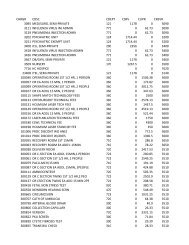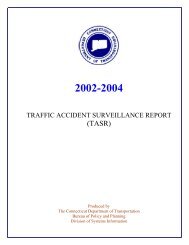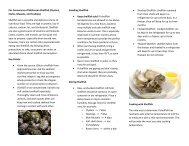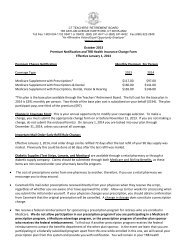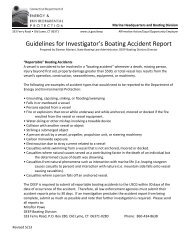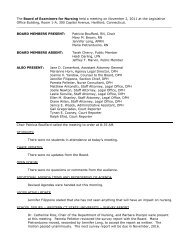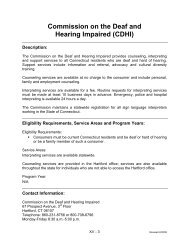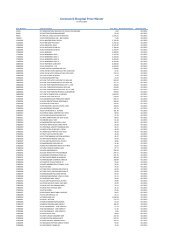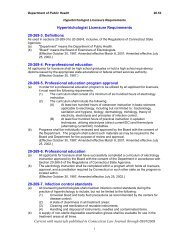Public Act 490 Guide - CT.gov
Public Act 490 Guide - CT.gov
Public Act 490 Guide - CT.gov
You also want an ePaper? Increase the reach of your titles
YUMPU automatically turns print PDFs into web optimized ePapers that Google loves.
The forester will familiarize himself or herself with the<br />
land, collect the required data, and complete the “Qualified<br />
Forester’s Report” provided by the State Forester's office<br />
along with the required mapping. Copies of the completed<br />
report are required to be filed with the forest landowner<br />
and the assessor in the subject town.<br />
Role of the Landowner: It is the landowner’s responsibility<br />
to maintain their forest land under the standards<br />
set forth under PA <strong>490</strong>. Any change of use of the classified<br />
land to some other use other than forest land would require<br />
reclassification and perhaps termination of the classification.<br />
It is important that the landowner submit a completed and<br />
signed M-39 application to the assessor on or before the<br />
required filing dates. Landowners should request a copy of<br />
the signed and dated application that is filed with the<br />
assessor and keep that copy for their records along with<br />
the Qualified Forester’s Report. Forest management, the<br />
harvesting of trees for timber or firewood, and the maintenance<br />
of woods roads are all acceptable permitted forest<br />
uses and would not impact the forest land classification<br />
under PA <strong>490</strong>. Once land has been classified as PA <strong>490</strong><br />
forest land, the landowner does not need to renew the<br />
application unless there is a change of use or change in title<br />
that requires a reclassification, in which case an updated<br />
Qualified Forester's Report, and a new M-39 application<br />
must be filed.<br />
Role of the State Agency: The State Forester has<br />
established and maintains the standards and policies by<br />
which forest land is evaluated by private professional<br />
foresters. The State Forester is to offer training and examination<br />
at least once per year to any forester seeking to be<br />
qualified to complete the Qualified Forester’s Report<br />
under PA <strong>490</strong>. The State Forester also acts on any appeal<br />
brought forth by a landowner or assessor regarding a<br />
forester’s findings.<br />
Definition of "Tract"<br />
"Tract" means a continuous or unbroken expanse<br />
of land under single ownership and bearing adequate<br />
tree cover generally distributed throughout the area.<br />
Only the following features shall be regarded as the<br />
bounds of a tract; acreage under a different ownership<br />
or acreage that does not meet the standards for<br />
forest land classification in CGS Section 12-107d-3<br />
of the Regulations of Connecticut State Agencies.<br />
Lines of demarcation drawn on maps, including but<br />
not limited to, municipal boundaries, assessor's lot<br />
lines and lines on subdivision maps are not to be<br />
regarded as a boundary of a forest tract.<br />
— Sec. 12-107d-1 (22) Connecticut Department of Environmental<br />
Protection Regulations Concerning Classification of Forest Land<br />
DETERMINATION OF PA <strong>490</strong><br />
FOREST LAND<br />
CGS Section 12-107b(2) defines “forest land” as:<br />
...any tract or tracts of land aggregating twenty five acres<br />
or more in area bearing tree growth that conforms to the<br />
forest stocking, distribution and condition standards established<br />
by the State Forester pursuant to subsection (a) of<br />
section 12-107d and consisting of:<br />
(a) one tract of land of twenty-five or more contiguous<br />
acres, which acres may be in contiguous municipalities,<br />
(b) two or more tracts of land aggregating twenty-five<br />
acres or more in which no single component tract shall<br />
consist of less than ten acres, or<br />
(c) any tract of land which is contiguous to a tract owned<br />
by the same owner and has been classified as forest land<br />
pursuant to this section<br />
During the 2004 legislative session, the General Assembly<br />
substantially revised the role of the State Forester in the<br />
administration of PA <strong>490</strong> forest land. The definition for what<br />
constitutes “forest land” did not change, but the administrative<br />
roles shifted. The State Forester no longer issues a<br />
“Certificate of Designation of Land as Forest Land.” Instead,<br />
the property owner is required to employ a private forester,<br />
trained and qualified by the State Forester, to examine the<br />
land and prepare a “Qualified Forester’s Report” on the land.<br />
That report must accompany form M- 39 “Application to<br />
Assessor for Classification of Land as Forest Land.”<br />
SE<strong>CT</strong>ION 6: FOREST LAND CLASSIFICATION<br />
EXAMINING LAND FOR CLASSIFICATION<br />
AS PA <strong>490</strong> FOREST LAND<br />
Once hired by the forest landowner, the forester will<br />
visit the land, developing both a forest stand map and<br />
sufficient inventory data to reliably describe tree species<br />
Connecticut Farm Bureau Association • http://www.cfba.org/pa<strong>490</strong>guide.htm • <strong>Public</strong> <strong>Act</strong> <strong>490</strong>: A Practical <strong>Guide</strong> and Overview<br />
15




